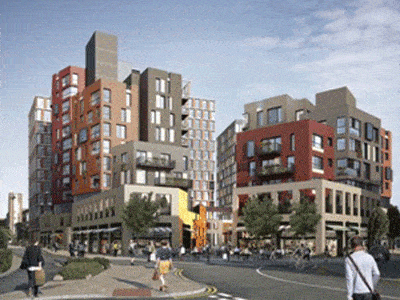Thames Valley offices in focus

The Thames Valley office market has seen a rapid improvement in occupier fundamentals over the past 12 months, according to data and analysis from the CoStar Group, writes Henry Murray, market analyst.
A considerable uptick in demand, coupled with limited new speculative construction and further removals of empty office buildings to alternative uses, resulted in the vacancy rate plunging to a cyclical low in Q2 2019 (see Exhibit 1a). Net absorption, the true indicator of occupier demand, has soared to decade highs over the past 12 months, with a spate of landmark deals driving annual absorption of around 1.8m sq ft as of May 2019 (see b in Exhibit 1).
Occupiers contributing to this surge over the past year include auditor KPMG, TMT giant Virgin Media, medical research firm IQVIA, housing association Sovereign and American telecoms firm Verizon. These firms will join the likes of SSE, Gartner, Thales and GreenValley, which moved into large spaces in the preceding years. Towns that have seen extensive regeneration and infrastructure projects have been the big beneficiaries, with net absorption particularly strong in Reading, Slough and Maidenhead. Co-working firms have also descended on Reading over the past 18 months to try and tap into demand from smaller firms, with momentum building ahead of Crossrail’s completion in 2020/21.
Increasing demand has created a supply deficit in the Thames Valley. Little new space has been built in the past five years, with conversions and demolitions actually resulting in a net loss of more than 1.2m sq ft (see a in Exhibit 2) of office stock over the period. Soaring residential house prices have encouraged many investors to reposition tired office buildings into alternative uses. Only a handful of large office schemes have delivered in the past couple of years. Among the most notable were two buildings in Slough: the Future Works (99,900 sq ft), which completed last year, and the Porter Building (119,400 sq ft), which delivered a year prior. Both schemes were built on a speculative basis and have seen decent demand since completion, at around 20% and 80% occupied, respectively. Little new space is expected to be added in the near term: only around 640,000 sq ft of office space is under construction across the Thames Valley, only around half of which is set to deliver within the next 18 months (see Exhibit 2b).
Supply pressures could ease in the medium term, however. A number of significant schemes have started construction recently. One significant project underway is The Landing in Maidenhead. The 368,000 sq ft mixed-use scheme is being developed by HUB and Smedvig and is set to deliver around 100,000 sq ft of Grade A office space in 2022. Elsewhere, a couple more buildings are being built at Green Park outside Reading, which total a combined 229,000 sq ft and are due to deliver 2021. More than 20 additional 100,000 sq ft-plus schemes are in the planning pipeline, too.
Among the most significant is the mixed-use Station Hill scheme in Reading, whose first phase kicked off earlier this year. The total scheme has planning consent for up to 900,000 sq ft, principally made up of office space. The scheme sits adjacent to Reading station, where Crossrail services are set to begin soon. The Crossrail route has been the focus for many developers of late.
What has all this positive momentum meant for rents in the region? Rental growth turned positive in the Thames Valley around five years ago, after several years of decline post-crisis. Rental growth has ticked along at about 5.5% per year since 2013, peaking at 7.9% in 2016 but remaining healthy at around 3.4% over the past year. The Thames Valley is currently outperforming the aggregate growth of the Big Six regional cities as well as London, with office rents in the capital currently in decline.
Oxford has been the strongest performer of late, with rents up by 6% over the past year. The likes of Reading, Wokingham, Slough and Bracknell Forest have also posted growth above the Thames Valley average. Restricted supply and rising demand have supported rental growth over this period, with many landlords choosing to refurbish buildings in order to capitalise on growing demand for better quality space. Rents in newly delivered or refurbished buildings command rents around £12/sq ft higher than poorer-quality, Grade B assets.
What about investment? Such positivity in the occupier market has attracted growing investor interest. Sales picked up sharply last year to total £1.5 billion, the third highest annual volume this cycle and an increase of around 50% year-over-year from 2017. Trading has cooled so far this year, with the £160 million spent in Q1 2019 representing a drop of around 35% on the region’s 10-year quarterly average (see Exhibit 3). But this was due more to wider political uncertainty than to any local factors, and reflects the national picture.
Investment has been driven by a range of buyers over recent years, but one particular buyer type has stood out: local authorities. South East local authorities have been among the most acquisitive since the Public Works Loan Board made it easier for councils to borrow at low rates and invest in income-producing assets in 2016. And the trend shows little sign of slowing down. Over the 12 months to May 2019, five of the top 10 investors in the region were local authorities, with investments totalling just shy of £500m. The most acquisitive were two councils from Surrey, Spelthorne and Runnymede, who have spent £950m and £300m, respectively, in the past three years. The former significantly bolstered these volumes with the standout deal from the past year or so: its acquisition of the Landid/Brockland portfolio. The portfolio consisted of three prime assets, Thames Tower (Reading), The Porter Building (Slough) and The Charter Building (Uxbridge), and sold for £285m in August 2018, representing a net initial yield of 6.14%.
Crossrail locations have been a key target for investors. CoStar’s latest data shows that investment in a three-mile diameter corridor along its route has seen investment volumes top £700m in the 12 months to May (see Exhibit 4). This is more than double the historical average for the route, which has historically seen around £310m in a rolling 12-month period. Buildings along the route will likely remain in demand in the near term, and not just for core investors. Positive demand, low vacancy and continued rent growth are likely to attract more opportunistic investors seeking higher returns through refurbishment or repositioning.
For more information on any of the topics covered in this piece, or for more news, analytics and data, get in touch with CoStar or visit the website:
0203 205 4500













